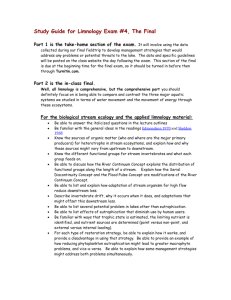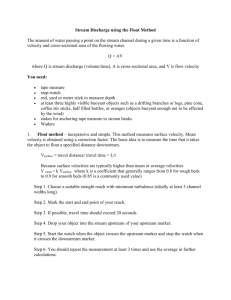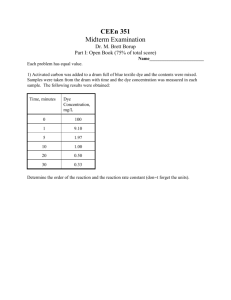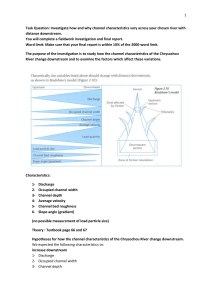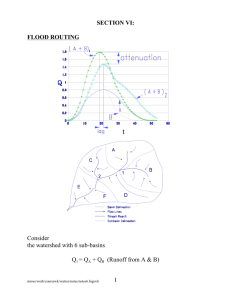LAB11 - CUNY.edu
advertisement
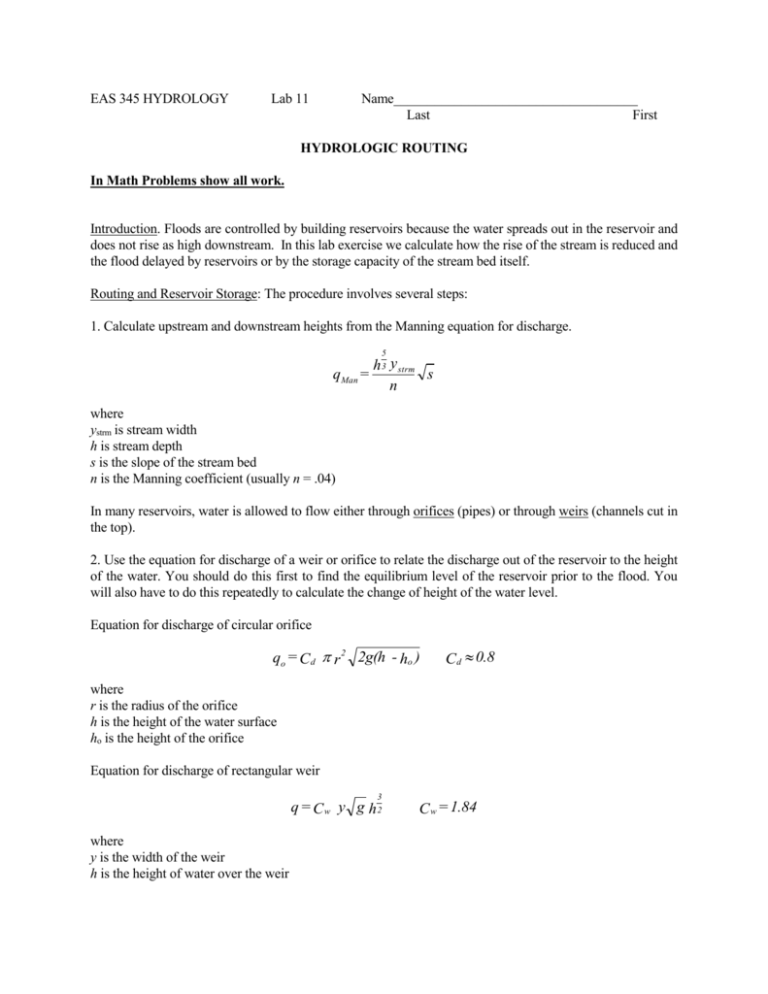
EAS 345 HYDROLOGY Lab 11 Name____________________________________ Last First HYDROLOGIC ROUTING In Math Problems show all work. Introduction. Floods are controlled by building reservoirs because the water spreads out in the reservoir and does not rise as high downstream. In this lab exercise we calculate how the rise of the stream is reduced and the flood delayed by reservoirs or by the storage capacity of the stream bed itself. Routing and Reservoir Storage: The procedure involves several steps: 1. Calculate upstream and downstream heights from the Manning equation for discharge. 5 h 3 y strm s q Man = n where ystrm is stream width h is stream depth s is the slope of the stream bed n is the Manning coefficient (usually n = .04) In many reservoirs, water is allowed to flow either through orifices (pipes) or through weirs (channels cut in the top). 2. Use the equation for discharge of a weir or orifice to relate the discharge out of the reservoir to the height of the water. You should do this first to find the equilibrium level of the reservoir prior to the flood. You will also have to do this repeatedly to calculate the change of height of the water level. Equation for discharge of circular orifice qo = C d r 2 2g(h - ho ) C d 0.8 where r is the radius of the orifice h is the height of the water surface ho is the height of the orifice Equation for discharge of rectangular weir 3 q = Cw y g h2 where y is the width of the weir h is the height of water over the weir C w = 1.84 3. Solve the storage equation for height of the reservoir in finite steps. h fut = hnow + t[ qin - qout ] ARes where hfut is the future height hnow is the present height ARes is the area of the Reservoir t is the time step qin is obtained from the Manning equation qout is obtained from the weir or orifice equation Warning: In all finite difference problems involvint time, if too large a time step, t, is chosen then the model will give absurd numbers and may well crash. Smaller time steps mean that more calculations are needed, which doesn't bother the computer too much. When calculating by hand, it is best to choose the largest time step possible. In the routing problem, the larger the area of the reservoir in relation to the maximum discharge, the larger the time step you can use. Water Storage in Streams. As a flood wave moves downstream, the river acts like a narrow reservoir as it swells. As a result, the hydrograph has a lower peak but broadens in the downstream direction assuming no tributaries. The purpose of this exercise is to calculate downstream changes of the hydrograph. The problem is solved by the program STRMROUT, but as usual, you must solve it by hand first. In this problem the stream is given two segments only. Long rivers can be divided into many segments. A crucial point of the problem is that each segment depends on the water it gets from the segment upstream. Therefore at each time step the procedure is to solve for upstream segments first, and work your way mathematically downstream. Warning: In large floods, the discharge in a river segment may also depend on the segment downstream if that becomes gorged and flow either backs up or slows down as a result. We will not consider that here. EAS 345 HYDROLOGY Lab 11 Name____________________________________ Last First HYDROLOGIC ROUTING In Math Problems show all work. 1. Solve the routing problem for a reservoir capped by a weir, given that, ARes = 5(10)6 ystr = 50 yweir = 20 s = .002 t = 3600 t qin 0 30 1 40 2 150 3 430 4 590 5 530 6 480 7 280 8 130 9 80 10 30 11 30 12 30 13 30 14 30 15 30 16 30 17 30 18 30 hupstr hRes qout hRes hdnstr 2. Solve the routing problem for a stream consisting of two segments, given that qb is the base flow and qs is the discharge entering the first segment y = 25 m x = 10 km t = 1000 s q = 40z4/3 Stream width length of stream segment Time increment Rating curve for stream Governing Equation for Height Change of a Stream Segment t z = [ qin - qout ] yx t qb qs 0 10 0 1 10 20 2 10 50 3 10 90 4 10 70 5 10 50 6 10 30 7 10 20 8 10 10 9 10 0 10 10 11 10 12 10 13 10 14 10 15 10 16 10 17 10 18 10 19 10 20 10 qtot z1 q1 z1 z1 q2 z2
